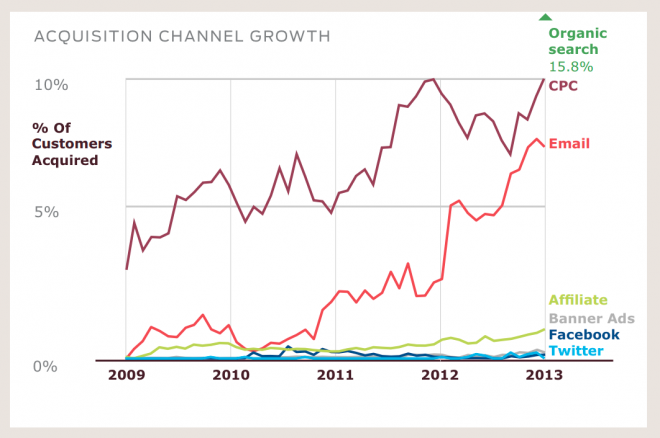Email marketing has been a mainstay of B2B marketing for more than a decade, and still greatly outperforms social media marketing and Facebook advertising – when you measure actual product sales.
In B2B marketing, email marketing often means a regular newsletter. The purpose can be quite simple – to remind prospects that you exist, and drive traffic to your website. The content often includes products offers, testimonial stories, and simple tutorial style articles.But regardless of the specific tactics used, email marketing content can easily be personalised, and is usually one of the lowest cost methods available to reach B2B clients and prospects.
A recent 2013 study by Custora looked at 72 million e-commerce shoppers at 86 retailers, examining which forms of digital marketing had the highest impact on actual product sales at online retail sites.
As you can see from the graph, the study found that email marketing, organic search results, and paid search engine marketing currently achieve much higher sales conversions than any form of social media activity or Facebook advertising.
The figures are clear, and correlate with typical industry click through rates for the various media. Email marketing can be highly effective, and is able to achieve a very attractive ROI because of the modest costs involved. It should be an important part of your monthly B2B marketing mix.
If your current email marketing is performing poorly, or failing to contribute towards your pipeline of opportunities, it might be because of one of these common mistakes.
- Mistake #1: Poor quality content
You need to find a balance between content quality and your desire to remind people of your promotions and products.
- Mistake #2: Talking to the same old crowd
You may have great content, but you should also offer something to get the email relationship started. Incentives to sign up should be loud and clear. Don’t hide rewards for signing up in the small print.
Simple things such as free reports or whitepapers, discount coupons, or promotional items are great ways to recruit email subscribers. Just make sure the offer is relevant or worthwhile for your target audience.

- Mistake #3: Be both boring and obnoxious
The rapidly rising use of smartphones for business email is important to consider. You should be careful to consider the time of day you will be sending your email.
Prospects don’t have unlimited time to listen to you, or read your marketing material. Show respect, and consider both what you say, and when.
- Mistake #4: Don’t segment your email list
Maintaining several different newsletters geared towards specific customer/prospect situations can reap serious rewards. It also makes it easier to build a relationship with your subscriber, as your content has a better chance of being relevant.
http://sebastianrice.wordpress.com/2013/07/29/4-email-marketing-mistakes-that-can-sabotage-revenue/









